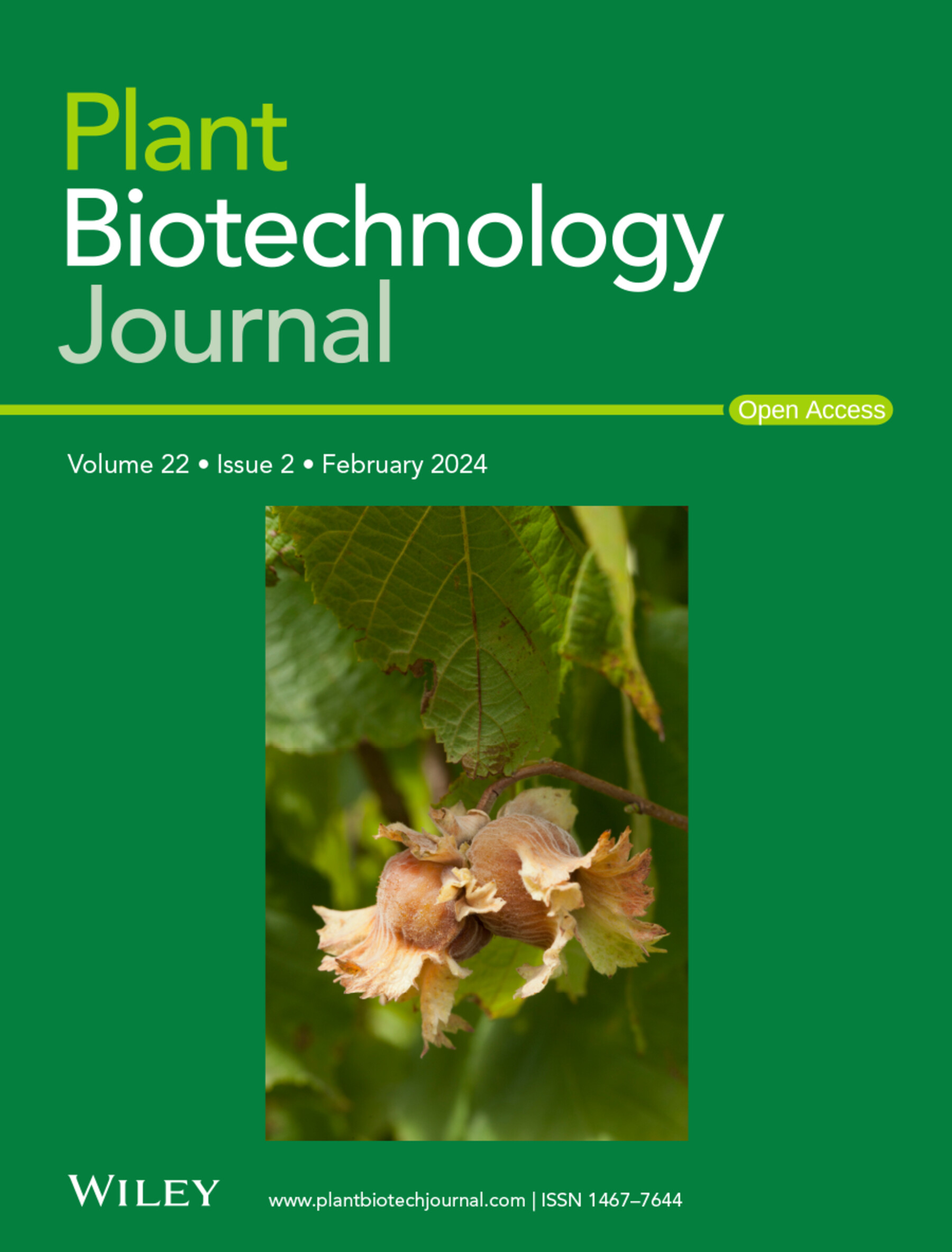大豆铁蛋白GmFER1具有提高大豆耐盐性和根腐病性,提高大豆产量的作用。
IF 10.1
1区 生物学
Q1 BIOTECHNOLOGY & APPLIED MICROBIOLOGY
引用次数: 0
摘要
植物的胁迫响应机制是由生物胁迫和非生物胁迫激活的,但其持续激活通常会影响生长。铁蛋白在调节生物量积累中的作用已在不同的植物物种中得到广泛的研究;然而,它对盐胁迫抗性和镰刀菌抗性的潜在机制仍然知之甚少。在这里,我们证实了铁蛋白的过度表达导致地上和根部的铁积累和Fe3+封存,激活铁的吸收和运输系统。更重要的是,GmFER1增强了盐胁迫抗性和镰刀菌抗性。首先,GmFER1定位于叶绿体中,受到盐胁迫和镰刀菌感染的显著诱导。GmFER1的过表达在不激活活性氧清除机制的情况下,通过提高净光合速率和Rubisco酶活性来提高大豆单株产量。在盐胁迫下,GmFER1通过提高SOD和CAT酶的活性以及Na+的外排能力来增强抗性。在镰刀菌感染下,GmFER1通过提高抗氧化能力增强对病原菌的抵抗力。此外,缺铁试验显示,盐胁迫下CAT和SOD活性的增加与铁离子积累有关。最后,分析了GmFER1基因变异对水稻耐盐性、抗病性以及与产量和品质相关的23个农艺性状的影响。对GmFER1基因变异的进一步分析表明,Hap2单倍型可能增强大豆的耐盐性、抗病性、荚果数和含油量。我们的研究提供了一种新的方法来减少生长惩罚,同时提高植物对盐胁迫和镰刀菌感染的抗性。本文章由计算机程序翻译,如有差异,请以英文原文为准。
GmFER1, a soybean ferritin, enhances tolerance to salt stress and root rot disease and improves soybean yield.
The plant stress response mechanism is activated by biotic and abiotic stresses, but its continuous activation typically affects growth. The role of ferritin in regulating biomass accumulation has been extensively characterized in diverse plant species; however, the underlying mechanisms through which it contributes to salt stress tolerance and Fusarium resistance remain poorly understood. Here, we confirm that overexpression of ferritin leads to iron accumulation and Fe3+ sequestration in both aboveground and roots, activating the iron uptake and transport system. More importantly, GmFER1 enhances salt stress tolerance and Fusarium resistance. First, GmFER1 is localized in chloroplasts and significantly induced by salt stress and Fusarium infection. Overexpression of GmFER1 increases soybean yield per plant by enhancing net photosynthetic rate and Rubisco enzyme activity, without activating the reactive oxygen scavenging mechanism. Under salt stress, GmFER1 enhances resistance by improving the activities of SOD and CAT enzymes, as well as Na+ efflux capacity. Under Fusarium infection, GmFER1 enhances resistance to the pathogen by boosting antioxidant capacity. Moreover, iron-deficiency tests revealed that increased CAT and SOD activities under salt stress are linked to iron ions accumulation. Lastly, we analysed the effects of GmFER1 gene variation on salt tolerance, disease resistance and 23 agronomic traits related to yield and quality. Further analysis of GmFER1 gene variation revealed that the Hap2 haplotypes could potentially enhance salt resistance, disease resistance, pod number and oil content in soybean. Our research offers a new way to reduce growth penalties while boosting plant resistance to salt stress and Fusarium infection.
求助全文
通过发布文献求助,成功后即可免费获取论文全文。
去求助
来源期刊

Plant Biotechnology Journal
生物-生物工程与应用微生物
CiteScore
20.50
自引率
2.90%
发文量
201
审稿时长
1 months
期刊介绍:
Plant Biotechnology Journal aspires to publish original research and insightful reviews of high impact, authored by prominent researchers in applied plant science. The journal places a special emphasis on molecular plant sciences and their practical applications through plant biotechnology. Our goal is to establish a platform for showcasing significant advances in the field, encompassing curiosity-driven studies with potential applications, strategic research in plant biotechnology, scientific analysis of crucial issues for the beneficial utilization of plant sciences, and assessments of the performance of plant biotechnology products in practical applications.
 求助内容:
求助内容: 应助结果提醒方式:
应助结果提醒方式:


